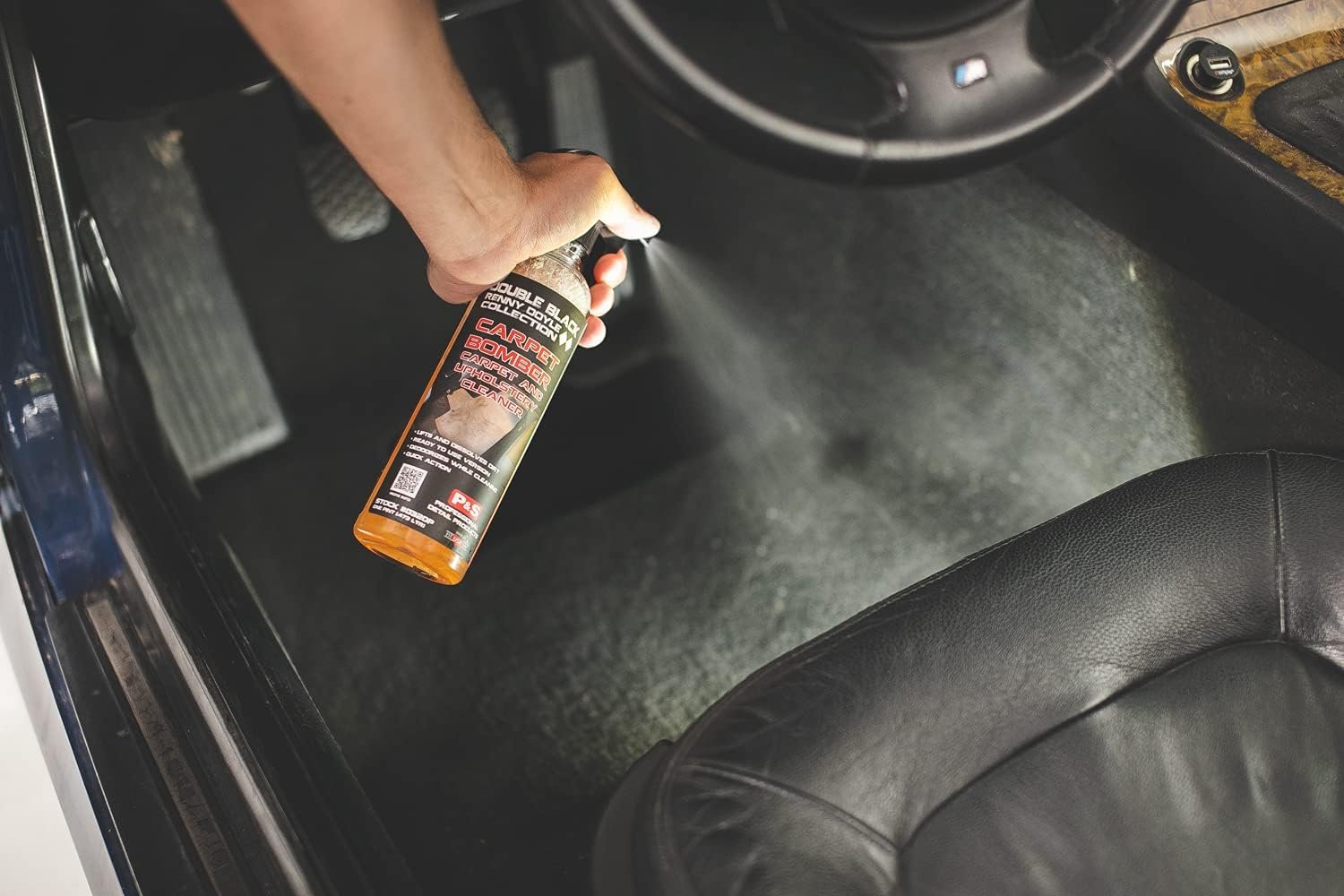Exploring the Fabric of Your Drive: 5 Types of Car Upholstery and How to Clean Them
Master the Art of Car Upholstery Care
Car interiors are more than just a functional part of your vehicle; they define the comfort and aesthetics of your ride.
Proper maintenance of car upholstery, from cleaning fabric stains to conditioning luxurious leather, can significantly enhance your car's value and lifespan.
With the rising demand for services like car interior shampoo near me or car seat cleaning services, knowing how to handle different upholstery types is essential.
In San Diego, we have all types of cars, from surfing drivers to family-abused cars and dog owners to luxury weekend rides. At Fresh Layer Mobile Detailing, we collect valuable information from all car interiors and are happy to share it with you.
Tools and Products for Car Upholstery Cleaning
Fabric Upholstery: Carpet Bomper from P&S for versatile stain removal.
Leather Upholstery: Koch-Chemie - Leather Star and Conditioner for a polished finish.
Vinyl Upholstery: P&S Xpress Interior Cleaner for easy maintenance.
Suede Upholstery: Sonax Alcantara Cleaner for gentle care.
Synthetic Upholstery: Xpress Interior Cleaner for deep cleaning.
Types of Car Upholstery
Characteristics, Cleaning Frequency, and Methods
Fabric
- Characteristics: Affordable, absorbs stains easily
- Cleaning Frequency: Vacuum weekly, deep clean every 3 months
- Best Method: Vacuum and shampoo with fabric cleaner
Leather
- Characteristics: Luxurious, prone to cracking
- Cleaning Frequency: Clean monthly, condition regularly
- Best Method: Use leather cleaner and conditioner
Vinyl
- Characteristics: Durable, resistant to spills
- Cleaning Frequency: Clean monthly, apply UV protection
- Best Method: Clean with vinyl-specific cleaner
Suede/Alcantara
- Characteristics: Premium, delicate texture
- Cleaning Frequency: Spot clean as needed, deep clean biannually
- Best Method: Brush and spot clean with suede cleaner
Synthetic
- Characteristics: Affordable, resistant to stains
- Cleaning Frequency: Vacuum weekly, deep clean every 3–6 months
- Best Method: Use multi-purpose or fabric cleaner
Cloth Upholstery: Comfort in Versatility
Cloth upholstery is a popular choice in mid-range and budget-friendly cars, and it is known for its affordability and comfortable touch. Cloth is commonly used in many vehicles due to its cost-effectiveness and comfort.
Cleaning cloth upholstery involves vacuuming to remove dust and loose dirt. Use a suitable fabric cleaner and gently scrub with a soft brush for stains. Rinse with a damp cloth and let it air dry.
Always test cleaning products on a hidden area first to ensure they don’t cause discoloration. In our detailing business, Carpet Bomper from P&S car upholstery cleaner works the best for this type of interior cleaning.
Pros
Non-slippery surface and a homely feel, offering maximum comfort.
Notably durable, withstanding regular wear and tear.
Cheaper and available in various designs, colors, and patterns.
Cons
It absorbs spills quickly, making it prone to stubborn stains.
Traps dust and allergens, potentially aggravating allergies.
Car manufacturers such as Honda, Ford, and Toyota commonly utilize cloth upholstery.
Cleaning cloth seats involves vacuuming to eliminate dust and loose dirt, followed by using a carpet and upholstery cleaners and a soft brush for stubborn stains. Rinely lightly with a damp cloth, avoiding soaking, and allow it to air dry. Patch-testing any cleaning product is critical to prevent potential discoloration.
Pro tip: Use a fabric protectant spray post-cleaning. It forms a protective layer on the fabric surface, repelling spills and stains.
Vinyl Upholstery: A Robust Performer
Vinyl upholstery, a popular choice for trucks, commercial vehicles, and family cars, offers durability and ease of cleaning.
Vinyl upholstery is durable and easy to clean, making it a popular choice for families and commercial vehicles. Use a simple solution of Xpress Interior Cleaner and warm water to clean vinyl seats.
Apply the mixture with a soft cloth, scrub gently, then rinse with a clean, damp cloth and dry with a towel to prevent water spots.
Pros
Incredibly easy to clean, typically requiring just a wipe-down.
Highly resistant to water and stains.
Durable and long-lasting with the right care.
Cons
In extreme temperatures, it can become uncomfortably hot or cold.
Without regular maintenance, it may develop cracks over time.
Brands like Jeep and GMC often opt for vinyl interiors due to its resilience. Clean vinyl seats with a gentle scrub using a soft cloth and a mild solution of dish soap and warm water. Rinse with a clean, damp cloth and towel dry to prevent water spots.
Pro tip: Use a vinyl conditioner to maintain its pliability and prevent cracks.
Leather Upholstery: Symbol of Luxury
Leather, synonymous with luxury and sophistication, is a preferred choice for premium vehicles.Leather offers a premium look and feel, but requires careful maintenance to keep it in good condition.
Use a pH-balanced leather cleaner and conditioner to clean leather upholstery. Apply the cleaner like Koch-Chemie - Leather Star with a microfiber cloth, then buff with a dry cloth. Condition the leather regularly to prevent cracks and keep it soft and supple.
Pros
Emits a premium, luxurious look and feel.
Highly durable and can last decades with proper care.
Adds a significant resale value to the vehicle.
Cons
Requires consistent maintenance to prevent drying and cracking.
It is expensive.
Luxury car manufacturers like Audi, Mercedes-Benz, and BMW favor leather interiors. Use a pH-balanced leather cleaner for cleaning, applied with a microfiber cloth, and then buffed dry. Regular conditioning keeps the leather supple and prevents cracks.
Pro tip: Avoid direct sunlight exposure as much as possible to prevent color fading and material degradation.
Synthetic Upholstery: The Fusion of Innovation and Practicality
Synthetic materials like nylon are commonly found in vehicles built for utility and resilience.Synthetic materials like nylon are hard-wearing and relatively easy to clean. Use a vacuum cleaner to remove loose dirt. For stains, don’t use a commercial upholstery cleaner or a homemade solution of vinegar, dish soap, and water. Better way to clean is use light interior cleaner like Xpress Interior Cleaner
Pros
Offers impressive durability and longevity.
Easy to clean.
Provides a smooth, modern look to the vehicle's interior.
Cons
Might not offer the same level of comfort and luxury as others.
Prone to static electricity buildup.
Utility-designed cars like the Subaru Outback or Honda CR-V often feature synthetic upholstery. Start by vacuuming loose dirt, then use a commercial upholstery cleaner or a homemade solution of vinegar, dish soap, and water for stains. Rinse with a damp cloth and allow it to air dry.
Pro tip: Using a fabric guard can help repel stains and prolong the life of synthetic upholstery.
Alcantara Upholstery: The Luxury Trendsetter
Alcantara, a synthetic material designed to mimic suede, adds a luxurious touch to high-end cars. Alcantara, a synthetic material designed to look and feel like suede, is found in high-end luxury vehicles. To clean Alcantara, use a microfiber cloth and a Sonax (206141) Upholstery and Alcantara Cleaner. Be gentle to avoid damaging the material, and always follow the manufacturer's care instructions.
Pros
Offers a luxe, suede-like texture adding a plush feel to the car's interior.
Despite its luxurious appeal, it's lightweight and durable, making it a favorite for sports cars.
Cons
Alcantara can be easily damaged if not cleaned correctly.
Often requires professional cleaning for best results.
Alcantara graces the interiors of brands like Lamborghini, Porsche, and Tesla. Cleaning involves using a microfiber cloth and a mild solution of soap and water. Gentle treatment is vital to avoid damaging this delicate material. Always follow the manufacturer's care instructions.
Pro tip: A professional-grade Alcantara cleaner and conditioner will maintain its soft and plush texture.
Guide to Cleaning Every Type of Car Upholstery
Keeping your car’s upholstery clean is not just about maintaining appearances—it's essential for preserving the interior’s comfort and extending its lifespan.
Whether you’re dealing with a daily driver’s cloth seats or the luxurious leather of a classic car, knowing the right cleaning techniques is key. In this guide, we’ll walk you through the best practices for cleaning various types of car upholstery.
1. Cleaning Cloth Upholstery
Fabric upholstery is a staple in most vehicles, offering comfort and affordability. However, its porous nature makes it prone to stains and odors if not properly maintained.
How to Clean Fabric Upholstery
Vacuum Thoroughly: Use a vacuum with an upholstery attachment to remove dirt and crumbs.
Apply Fabric Cleaner: Spray a specialized fabric cleaner, such as CarPro Inside Cleaner, over the surface.
Scrub Gently: Work the cleaner into the material using a soft-bristle brush.
Blot Dry: Use a clean microfiber towel to absorb excess moisture.
Air Out: Leave the car windows open for ventilation and faster drying.
Pro Tip: Address spills immediately to prevent stains from setting in.
2. Leather Upholstery: Luxury and Longevity
Leather interiors exude sophistication and comfort but require diligent care to avoid cracks, discoloration, and wear.
Cleaning Tips for Leather Upholstery
Dust First: Use a microfiber cloth to remove surface dust and debris.
Apply Leather Cleaner: Opt for high-quality leather cleaners like car interior detailer solutions that protect and enhance the material.
Condition Regularly: Leather conditioners restore moisture and prevent cracking, keeping your seats supple for years.
Pro Tip: If your leather upholstery has stubborn grime, consider a car seat steam clean or seek help from a car seat cleaning service.
3. Vinyl Upholstery: Rugged and Resilient
Vinyl seats are a popular choice for commercial and family vehicles due to their durability and ease of cleaning. They are resistant to stains but can crack over time without proper care.
Cleaning Tips for Vinyl Upholstery
Wipe Down: Use a damp cloth to clean the surface before applying a car upholstery cleaner machine.
Clean with Vinyl-Specific Products: P&S Xpress Interior Cleaner is a great option for maintaining vinyl seats.
UV Protection: Apply a UV-protectant spray to prevent fading and cracking.
4. Suede and Alcantara Upholstery: Soft and Sophisticated
Suede and Alcantara are premium materials known for their unique texture and high-end appeal. However, they are more delicate than other upholstery types and require careful handling.
How to Clean Suede and Alcantara Upholstery
Brush the Surface: Use a dedicated suede brush to remove dirt and restore the texture.
Spot Clean: Apply a suede cleaner, like Sonax Alcantara Cleaner, to targeted areas.
Blot with a Microfiber Towel: Gently remove excess moisture without soaking the material.
Allow to Air Dry: Avoid direct sunlight or heat, which can damage the material.
Pro Tip: Always test cleaning products on an inconspicuous area before applying them to the entire seat.
5. Synthetic Upholstery: Durable and Practical
Synthetic materials like microfiber and polyester are commonly used in modern cars for their durability and resistance to stains. These materials are perfect for busy lifestyles and families with kids or pets.
How to Clean Synthetic Upholstery
Vacuum the Surface: Remove debris with a vacuum, paying extra attention to seams and crevices.
Apply an All-Purpose Cleaner: Use a safe, multi-purpose cleaner like Chemical Guys Fabric Clean.
Scrub Lightly: Work the cleaner into the material using a soft brush.
Blot Excess Moisture: Dry the surface with a clean microfiber towel.
Pro Tip: Avoid using excessive water, as it can weaken synthetic fibers over time.
Advantages of Using Professional Services
Why Choose a Car Seat Cleaning Service?
Expertise: Professionals know how to clean and protect different materials.
Time-Saving: Get your car cleaned without lifting a finger.
Advanced Tools: From steam cleaners to upholstery machines, services like car upholstery cleaner near meensure thorough cleaning.
DIY vs. Professional Upholstery Cleaning
Weighing the Pros and Cons
DIY Cleaning
Pros:
- Cost-effective
- Convenient for small stains
Cons:
- Requires time and effort
- May lack professional-grade results
Professional Cleaning
Pros:
- Advanced tools like car upholstery cleaner machines
- Expert handling of all material types
- Saves time and effort
Cons:
- Higher upfront cost
Conclusion
While cleaning your car’s upholstery can maintain its appearance and prolong its life, sometimes, DIY methods may not be enough for stubborn stains or delicate materials. In such cases, consider hiring a professional detailing service for thorough cleaning and maintenance. Regular care of your vehicle's upholstery not only ensures a comfortable ride but also enhances the resale value of your vehicle. Happy driving, and even happier cleaning!
FAQs
-
The frequency of cleaning depends on the usage and type of upholstery. However, a good rule of thumb is to deep clean your car's upholstery every three months.
-
Yes, you can use homemade solutions. However, always perform a patch test to ensure it doesn't discolor or damage the upholstery.
-
For regular maintenance, personal care should suffice. However, for deep cleaning and delicate materials like leather and Alcantara, professional service is advisable to prevent damage.
-
Regular cleaning, using the right products, and keeping the upholstery out of direct sunlight can significantly prolong its life.
Keep Your Car Looking New
Your car’s interior deserves as much attention as its exterior. Understanding the unique needs of different upholstery types ensures effective cleaning and long-lasting maintenance.
With the right products and techniques, you can keep your car seats looking pristine and extend their lifespan.Embrace this guide and let your car's interior shine, reflecting its true value and your attention to detail.
Remember, regular maintenance is the key to keeping your upholstery in peak condition and ensuring your vehicle's interior stays as good as new for years to come.










